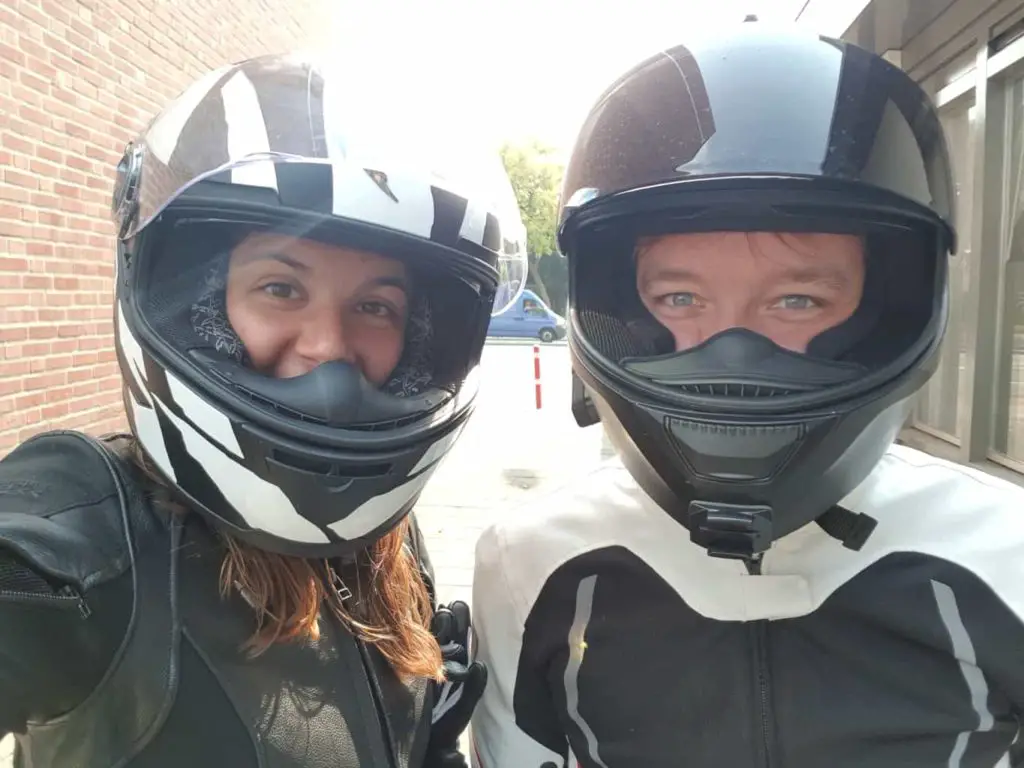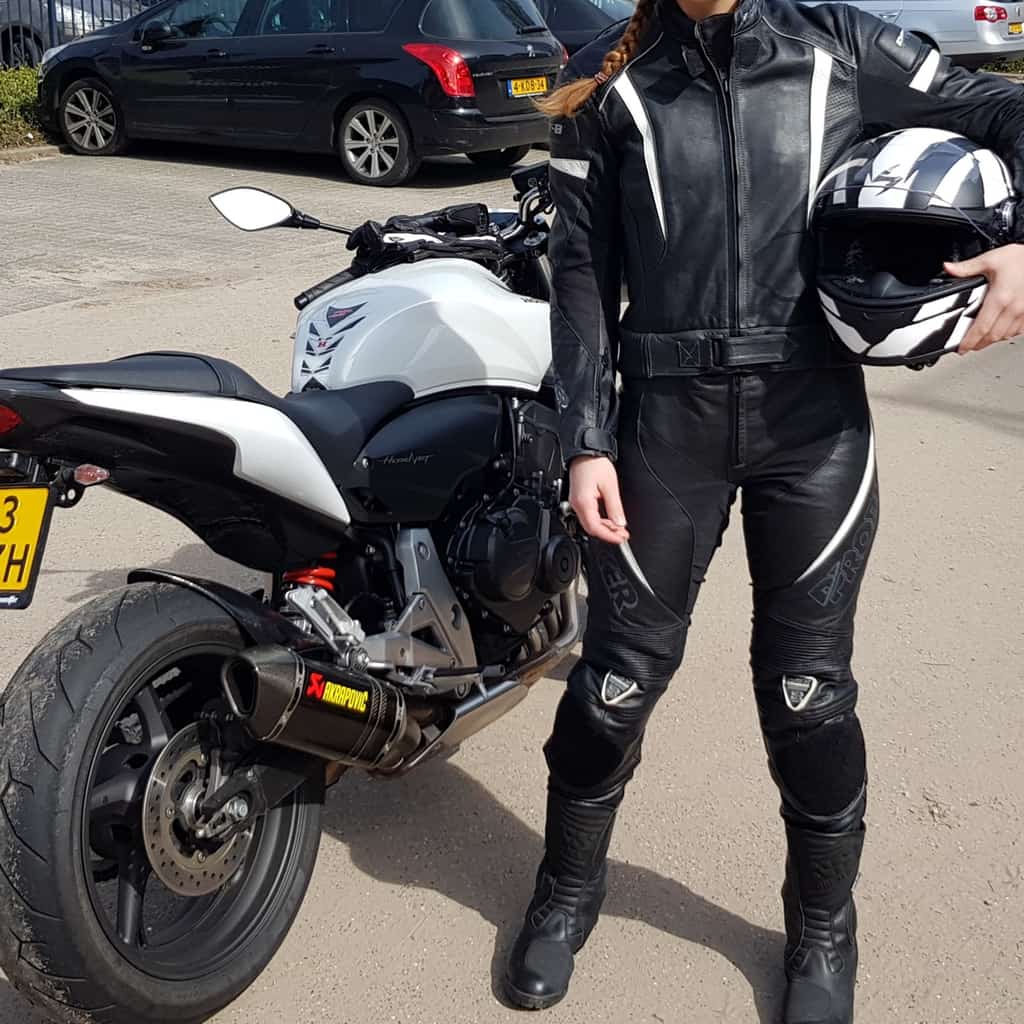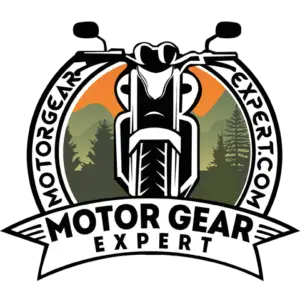Riding a motorbike is a thrilling experience, but sharing that with a friend only doubles the fun. However, with double the fun comes doubled responsibility given that not only your safety is at stake, but also your passenger’s.
When learning how to drive a motorcycle, chances are that you had little to no experience on carrying a “pillion rider” – passenger carried on a bike’s rear seat, pillion -, so with that in mind, I prepared a guide for you to make this shared experience a pleasant one.
Handling a motorbike with a passenger
I’ll start by stating the obvious: riding a motorcycle requires experience and doing it with a passenger on the back asks for extra skills. So, if you are a beginner rider you might want to put on some more riding hours to boost your handling skills before you allow someone on your saddle.
The person’s extra weight on the bike means that it will become heavier than what you are used to, so steering won’t go as smoothly and rapidly.
Breaking will naturally require a longer time and distance. This means that you’ll have to apply the brakes earlier and smoother. Tip: plan your stops in advance. This will avoid abrupt stops that might shock your passenger. If a sudden breaking is required, you’ll need to apply far more force than in a usual solo ride.
In slow maneuvers, it is advisable to use the trail breaking technique with the rear brakes. This should be more effective given the extra weight over the back tires, making the ride smoother.
Instinctively, accelerating will require more time and with the extra weight on the saddle, chances of an accidental willy are greater. If your passenger is still not up for a more daring ride, my recommendation is: smooth acceleration all along. Your passenger will thank you and so will your motorcycle.

Another tricky thing is keeping your balance at a stop. Some pillion riders will follow their natural instinct and rest their feet on the ground in the hope that it will help you to support the motorbike. That has the opposite effect, so ask your passenger to sit still even at a stop so you can be in full control of the bike’s balance.
Adjusting the motorbike for a passenger
Certain features of the motorbike can contribute to making the passenger’s ride safer, pleasant and more comfortable.
I’ll state the obvious at first: keep in mind the size of your bike! It’s only natural that the extra weight will require a harder work from your motorbike, so the bigger and the more powerful it is, the easier it will handle the second person on top. Large cruisers, touring bikes and big sports bikes have a greater capacity for weight. 450cc motorbikes can generally take up to 200kg, for example. You can find the average weight of each type of motorcycle in this article.
Each motorcycle has its own capacity, a rating called GVWR, which can be checked in the user’s manual. There you will also find advice on how to adjust your suspensions and tire pressure to bear the eventual extra weight. If you’re going for a quick ride there’s no real need for this, but if you want to cover larger distances you should definitely make these adjustments.
As comfortable as your motorbike may feel to you as a rider, the same can’t always be said for the passenger. So make sure, especially when you’re going for a longer ride, that you have everything to provide the passenger with a comfortable ride.
Saddles, footrests, backrests, and handles
The basic set-up for a pillion rider includes a rear seat and footrests. Ideally, the saddle should be wide enough to provide comfort, making your passenger feel secure, and long enough to allow for some room between you two.
This space allows him/her to comfortably adjust their position without interfering on yours. Avoid saddles that slope to the front, as the passenger might tend to slide onto you. Also, avoid those that bend downwards in the back: it gives the passenger the feeling that they might slide off the saddle.
If your passenger’s still not happy with the seat, there are a few ways to improve its comfort:
- Advise the passenger to switch positions, for example leaning forward onto the rider, then standing upright. Resting the tip of the toes on the foot-pegs, then the center of the feet and then the heels for a bit of a stretch. But, beware: any movement on top of the motorbike will translate into how the motorcycle will behave on the road. Therefore make sure that your passenger won’t do any sudden movements without letting you know in advance.
- Take breaks to stretch the legs, arms, and back.
- Upgrade your saddle with a (gel) seat pad.
- Wear cycle shorts with padding and compression. It not only provides comfort, but the right amount of compression improves blood circulation and support the muscles avoiding fatigue and soreness.
- Order a whole new seat custom-made for the bike and passenger’s butt. Heads-up: this might be the best but also most expensive option!
- Otherwise, make your own saddle by sculpting the foam or gel of your preference.
Footrests are essential for an adequate seating position. Not only that, but they are also legally required in most of the countries. Its position can be a problem if the passenger’s legs are kept in an uncomfortable angle or if it makes it hard for him/her to support themselves on their legs – particularly important over bumps and turns.
Here there are mainly two options: a pair of footpegs or floorboards. Floorboards are preferred for providing support to the whole foot, unlike the footpeg which puts pressure across a single spot of the foot. The floorboard thus allows for a variety of different leg positions, making it more comfortable. Besides, those who use it also say it reduces vibration dramatically. But, small detail: these are seldom found as an option for a sports motorbike. So you’re luckier if you have a touring or cruiser motorcycle. And if the pegs are your only option, you can always opt for an adjustable one, then you can find the ideal height and position to make it the most comfortable to your passenger.
You can also upgrade your passenger seat with a backrest. This is a great option for longer miles. Only some motorbikes come with this feature, but for many of them, you can find aftermarket or OEM parts to install. Some backrests even double as top cases or rear racks, then your bike can comfortably accommodate the passenger as well as the luggage that might come along! For cruiser-style motorcycles, a sissy bar is the option to go for. Remember: the wider and most padded, the happier your passenger will be.
The most common way for the pillion rider to keep in place is by holding onto the driver’s waist. Or, if the passenger is long enough, holding onto the tank is a possibility as well. Now, some might feel uncomfortable or unsafe with this arrangement, which is not a big deal because there are other options.
Some backrests and rear racks come with a support where the passenger can hold onto. The disadvantage is that the support will be slightly behind the passenger, which might feel intuitively less safe than leaning forward onto the rider.
Still, there’s another option: using a driving belt. The belt is placed around the driver’s waist and the passenger is able to hold onto its handles which are usually placed on both front and back sides of the driver.
Lastly, there is the gas tank pillion handle. The position doesn’t differ from just holding onto the tank, but the handle itself surely does give a better grip.
Passenger Instructions (How to Be a Good Passenger)
Going through a few riding instructions with your passenger before going for a ride will save you from trouble. Trust me, you do want to have a good passenger on your motorbike, so instruct them on how to be one. Here are some tips:
- Your passenger should only get on the motorcycle after you, only after you’ve put the bike upright by bracing it with your legs on both sides. Same goes for when they get off, always before you. This way it will be easier for you to maintain the bike’s balance with the extra weight put on top.
- Always hop on and off on the left side of the bike. Let them know the hot muffler is positioned on the bottom right of the motorcycle, so avoid that area to ensure they don’t get burned.
- Ask them to hold tightly onto you or to the handholds. A loose grip will cause them the sensation that they are about to slip off the motorcycle when you accelerate. The best is when they can keep their body tight to yours to also avoid banging against each other under heavy braking.
- Remember that because of the proximity, the passenger has to hold his/her head in place in order to avoid the helmets smacking against each other when reducing speed or breaking. This will wear out the helmets much faster.
- No sudden movements, never! First-timers will naturally be afraid of falling off in turns so their natural response will be to lean the opposite direction. This won’t help you, in fact, it will make you lose balance. The best tip to give them is to lean with you and look over your inside shoulder at all times. The consistent movement between you two will help you maintain the balance much more easily.
- Keep the feet on the pegs at all times. It might sound obvious to you, but you would be surprised with how many passengers tend to put their feet down at a stop. So, beware of that, and instruct your passenger by letting them know they should only put their feet down when you say it is safe to do so when the ride is over.
- Riding on the rear saddle can be tiring, especially when it is an uncomfortable one so make sure to agree on breaks. Your passenger will also want to move a bit from time-to-time to adjust their position, so let them know they shouldn’t do so during turns, hard accelerations or breakings. It is possible to do so when you’re driving straight and not so fast, but the best is to always let the driver know before any hard movements.
Communication between the rider and the passenger
Communication is key in a two-up motorbike ride. As I said before, the passenger might need a break to stretch or might want to adjust their sitting position. In any case, communication is needed. But, verbal communication is nearly impossible, unless you’re driving 30km/h with your visors open and screaming out of your helmets. This is what you might do instead:
- Agree on a plan before starting to ride. Plan a ride duration, a destiny, a break, a quick stop. Explain to your passenger about the ride, what it feels like when accelerating, braking and turning. Make sure it is all clear, agreed and understood so no surprises come along.
- Establish hand signals. Determine a gesture or a kind of touch, such as a tap, so the passenger can indicate if they would like to slow down, stop, adjust their position or if they have a problem. But also determine positive gestures that can indicate that the passenger is enjoying the ride or would like to speed up. This is a simple way of getting instant feedback from the passenger and allow you to tailor the experience to their preference. A happy passenger is a good passenger!
- The best option, however, is to have a headset communication device. This is by far the easiest way to talk to each other.
What should the passenger wear

It’s very likely that the person you invited to ride along does not have all the safety gear to join you. Then what should both of you do? It doesn’t matter how experienced or how good a rider you are, safety gear is indispensable. Motorcycle accidents can happen and they can easily be very nasty ones.
It’s understandable that they wouldn’t one to spend hundreds on getting geared up to start with, so here are tips on making it cheaper:
- If you have an extra helmet, let your passenger use it, but if and only if it fits their head.
- Do not ever get a second-hand helmet! Helmets completely lose their safety standards if they have been hit before. Since you will never be able to be sure on that, do not gamble with your, or worse, someone else’s life.
- Gloves are essential, we all know that in an eventual fall, the first thing we use to support and protect ourselves are our hands, so they would very likely get scratched and injured in the event of an accident. The passenger should either borrow one or invest in a non-expensive set of leather gloves.
- The same applies to the motorbike suits or jacket and pants set. Going second-hand is a cheaper and safe option. Be sure to check the state of the clothes and look for their safety stamps. You don’t want to get clothes that are much scratched or ripped, missing paddings and protections or that haven’t been approved by safety standards.
- Do the same with motorcycle boots and do not forget to check their zippers and Velcro.
Some might say that for a quick ride from here to there, with a passenger who will only ride on your bike once or twice, it’s unnecessary to use all these gears. Just a helmet and thick leather or jeans clothes would do just fine. In fact, under the law of most countries, the only safety gear mandatory is the helmet. But, without a doubt, all the equipment mentioned above will provide much better safety to your passenger. For that reason, I would recommend that either your passenger invests on these or you get some extra to fully equip whoever is going up on the bike with you.
A Short Recap
Surely that was a lot of information, so I’ll remind you of most of it with a few key points to ensure that your two-up ride will be a successful one for you and your passenger:
- Ride smooth! Plan braking ahead and use trail breaking.
- Make sure your motorcycle has enough power and can handle the weight. You might have to adjust suspension and tires pressure.
- For a comfortable pillion ride, consider footrests; saddles; handles and backrests.
- Instruct them! Position, holding, do’s and don’ts. No feet down at stops and no sudden movements on top of the motorbike. Keep the movement consistent with the rider’s.
- Communication is key. If you don’t have a communication system, establish gestures and signals.
- Gear up and be safe at all times!
